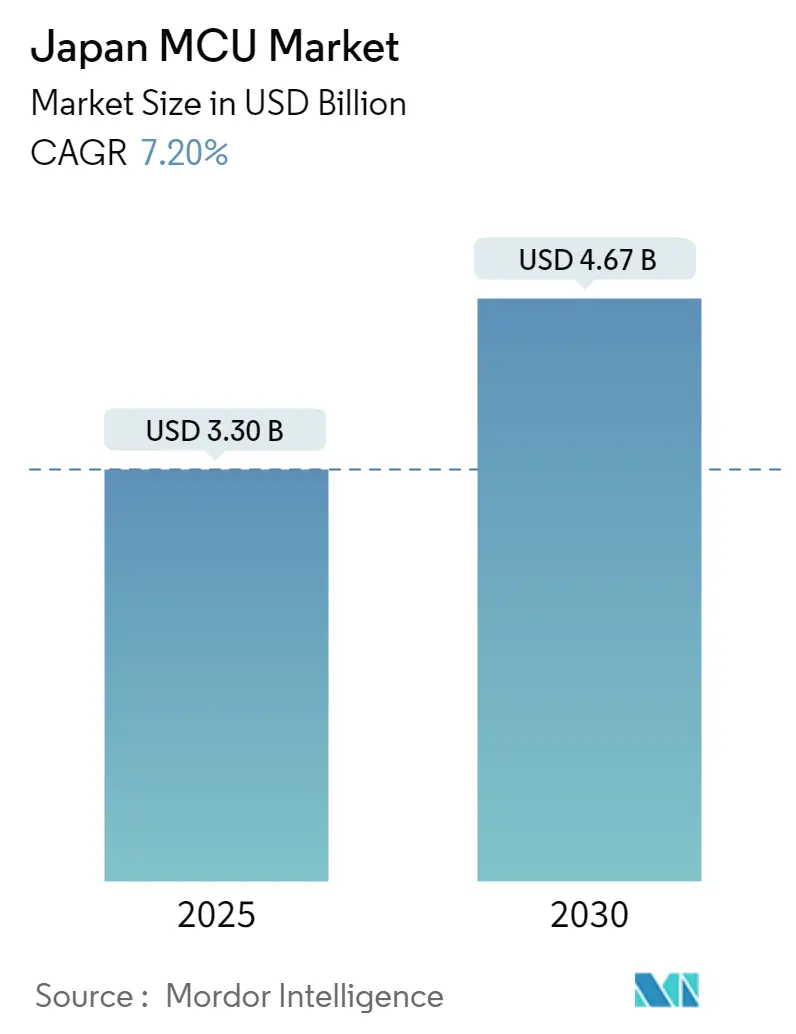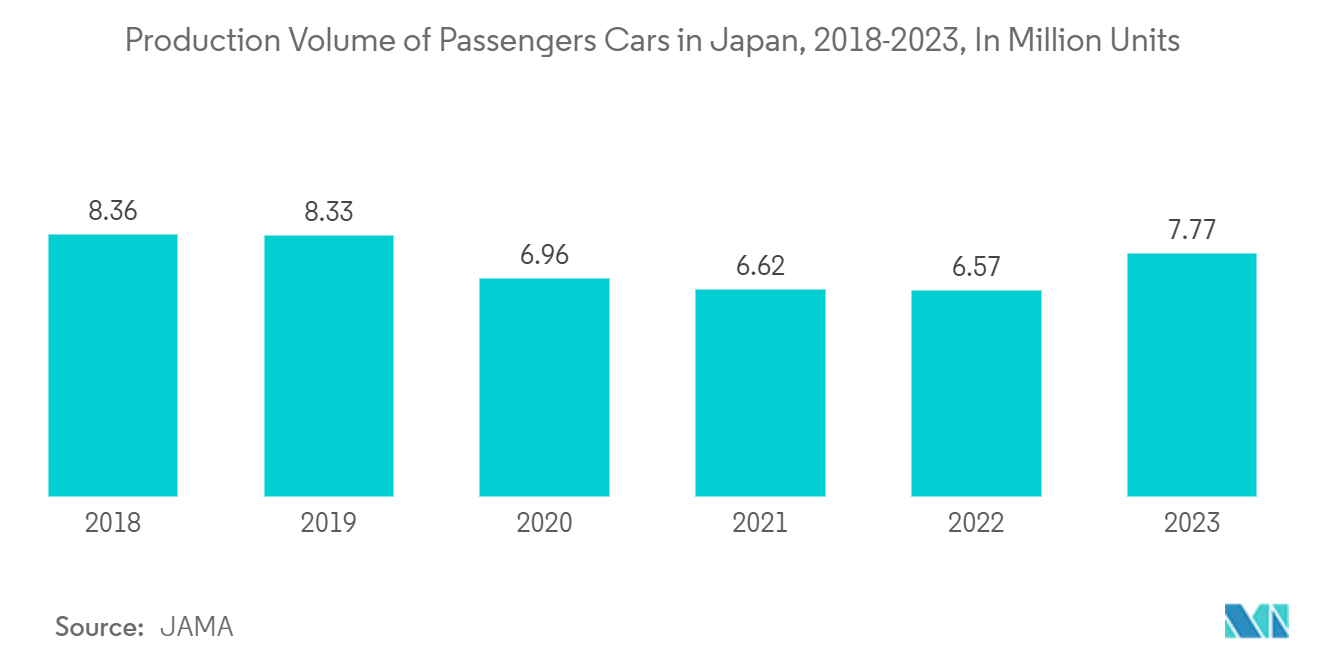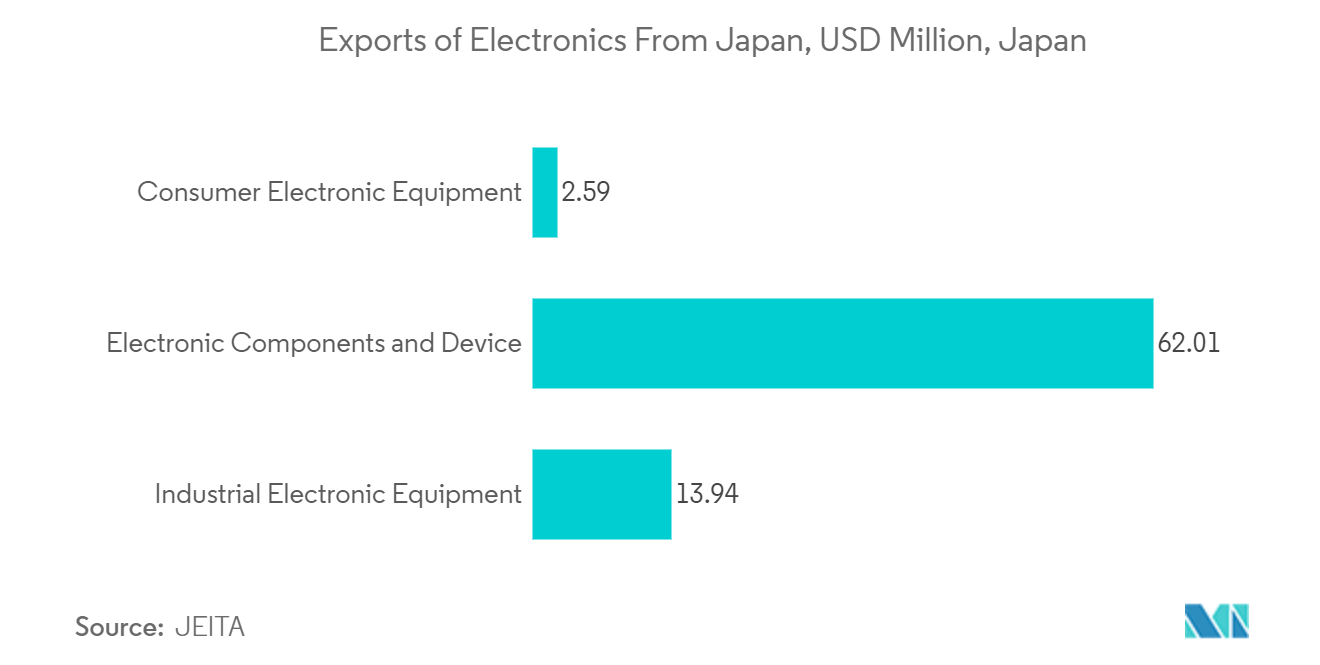Japan MCU Market Size and Share

Japan MCU Market Analysis by Mordor Intelligence
The Japan MCU Market size is estimated at USD 3.30 billion in 2025, and is expected to reach USD 4.67 billion by 2030, at a CAGR of 7.2% during the forecast period (2025-2030).
Japan emerged as a significant hub for semiconductor manufacturing and semiconductor-based devices. The country has some of the most prominent electronics and automotive manufacturing companies. It contributes significantly through various applications of microcontrollers like industrial automation, automotive pharmaceutical, consumer electronics, robotics, and other end-user industries.
- The rising consumer disposable income and their preferences for smart business environments and smart homes are crucial drivers for the growth of consumer electronics in Japan. Microcontrollers are used in many home appliances, such as washing machines, air conditioners, vacuum cleaners, refrigerators, motor control, front panel keypad control, analog sensor measurements, and LED/LCDs.
- In addition, Japanese companies pay attention to constant innovation and upgrades to keep up with the global industrial development of microcontrollers. For instance, Renesas Electronics, a Japanese semiconductor manufacturer, has announced to invest more than 50% of its manufacturing capacity by 2023. The company will focus on producing high-end microcontrollers and other key components for automobiles and electronic devices. Renesas is targeting 40,000 200mm wafers per month by procuring more lines for outsourced production at chip foundries.
- Fluctuating costs and a disrupted supply of raw materials are anticipated to restrain the growth of the studied market. Microcontrollers comprise several raw materials, like silicon, germanium, gallium arsenide, and silicon carbide. The increasing demand for consumer electronics and wireless communications and growing demand for energy-efficient microcontrollers factors, such as the shortage of silicon wafers coupled with the ROI metrics, will hamper the market growth.
Japan MCU Market Trends and Insights
Automotive Sector Holds Significant Market Share
- The growing vehicle electrification and automation, stringent government regulations and consumer demand for increased safety, reliability, comfort, and efficiency, and increasing need for security across all automotive applications are major factors driving the adoption of automotive microcontrollers globally.
- The significantly growing electric vehicle market, alongside the integration of MCU in the operational model, is expected to accelerate the demand for microcontrollers during the forecast period.
- Growth in automotive microcontroller sales mainly depends on vehicle sales and production trends, along with the increase in semiconductor deployment per vehicle, driven by the proliferation of electronic features throughout the vehicle. Due to the high degree of regulatory scrutiny and safety requirements, the automotive industry is characterized by stringent qualification processes, zero-defect quality processes, functionally safe design architecture, high reliability, extensive design-in timeframes, and extended product lifecycle, which result in significant growth of microcontrollers in the sector.
- Several automobile manufacturers are expanding their production facilities in Japan to meet the growing demand and stay ahead of the competition. For instance, in June 2024, ROHM Co Ltd, a power semiconductor device manufacturer headquartered in Japan, has introduced its EcoSiC brand as a trademark for products utilizing silicon carbide (SiC). The unveiling of the EcoSiC brand is strategically aimed at enhancing performance, promoting sustainability, and driving technological innovation.

Increasing Usage of Electronic Devices
- The increasing demand for the Internet of Things and artificial intelligence in consumer electronics and home appliances is driving the demand in the microcontroller market. Further, the demand for smart buildings and home automation drives the market.
- The country's microcontroller market is also driven by the increasing adoption of smart devices, including smartphones, as they can be conveniently connected to IoT devices. The Japan Smartphone Security Association (JSSEC) estimates that domestic smartphone users could reach 68.8 million by 2022.
- Moreover, according to the same organization, the monthly domestic shipment volume of mobile phones in Japan reached 1.42 million units in July 2022 and 0.68 million in May 2022.
- Furthermore, several electronic device manufacturers are expanding their presence in Japan, creating a high demand for microcontrollers. For instance, in December 2022, Kyocera, a leading supplier of electronic devices, mobile phones, automotive components, semiconductor packages, and others, announced to build a new manufacturing plant in Japan to advance its business expansion goals. The company aims to increase international and domestic production capacity through this plant.
- Companies in the market are developing new products to provide their customers with various solutions. For instance, in June 2022, NXP Semiconductor announced a new MCX portfolio of microcontrollers developed to advance innovation in smart homes, smart factories, smart cities, and many emerging industrial and IoT edge applications.

Competitive Landscape
With their wide-scale availability of offerings, the wide range of applications of microcontrollers contributes to intense rivalry among the key market players. The major providers are in the process of the constant evolution of products, following different strategies to capture the market. The players look forward to strategic collaboration with other brands and joint product developments to develop innovative solutions.
June 2022: Renesas Electronics Corporation announced a strategic partnership with Cyberon Corporation to provide voice user interface (VUI) solutions for customers using Renesas' entire RA MCU line. The customers will have complimentary access to Cyberon's command-based VUI toolchain, enabling them to add voice recognition to various endpoint applications in home appliances, building automation, industrial automation, wearables, and many more.
April 2022: STMicroelectronics NV extended Microsoft Azure RTOS development across its high-performance, mainstream, ultra-low-power, and wireless microcontrollers. The Azure RTOS suite is fully supported in the STM32CubeIDE tool and the STM32CubeMX initializer, which can directly configure Azure RTOS components.
Japan MCU Industry Leaders
-
Infineon Technologies AG
-
Analog Device Inc.
-
Texas Instruments Incorporated
-
NXP Semiconductor
-
Microchip Technology Inc.
- *Disclaimer: Major Players sorted in no particular order
-Market---Market-Concentration.webp)
Recent Industry Developments
- February 2024: Sony Semiconductor Solutions Corporation (“SSS”), DENSO Corporation (“DENSO”), and Toyota Motor Corporation (“Toyota”) have disclosed additional investments in Japan Advanced Semiconductor Manufacturing, Inc. (“JASM”), a manufacturing subsidiary primarily owned by TSMC, located in Kumamoto Prefecture, Japan. This investment aims to establish a second fab, slated to commence operations by the close of 2027.
- October 2023: Taiwan Semiconductor Manufacturing Co. (TSMC) is set to commence equipment installation at its new chip plant in Japan, showcasing a notably swifter pace compared to its U.S. counterpart. The Kumamoto facility will initially adopt 28-nm and 22-nm production technologies, known for their maturity, enabling the production of a variety of chips, including image sensors, driver integrated circuits, and microcontrollers, pivotal components found in a range of devices from smartphones to automobiles.
Japan MCU Market Report Scope
A microcontroller is a small computer on a single VLSI-integrated chip. They differ from desktop computers in that they are typically dedicated to a single function and are mostly embedded in other devices (cell phones, consumer electronics, among others).
Japan Microcontroller (MCU) market is segmented by type (4 and 8-bit, 16-bit, 32-bit), application (aerospace and defense, consumer electronics and home appliances, automotive, industrial, healthcare, data processing and communication). The market sizes and forecasts are provided in terms of value (USD) for all the above segments.
| 4 and 8-bit |
| 16 bit |
| 32 bit |
| Aerospace and Defense |
| Consumer Electronics and Home Appliances |
| Automotive |
| Industial |
| Healthcare |
| Data Processing and Communications |
| Other End-use Industries |
| By Product | 4 and 8-bit |
| 16 bit | |
| 32 bit | |
| By Application | Aerospace and Defense |
| Consumer Electronics and Home Appliances | |
| Automotive | |
| Industial | |
| Healthcare | |
| Data Processing and Communications | |
| Other End-use Industries |
Key Questions Answered in the Report
How big is the Japan MCU Market?
The Japan MCU Market size is expected to reach USD 3.30 billion in 2025 and grow at a CAGR of 7.20% to reach USD 4.67 billion by 2030.
What is the current Japan MCU Market size?
In 2025, the Japan MCU Market size is expected to reach USD 3.30 billion.
Who are the key players in Japan MCU Market?
Infineon Technologies AG, Analog Device Inc., Texas Instruments Incorporated, NXP Semiconductor and Microchip Technology Inc. are the major companies operating in the Japan MCU Market.
What years does this Japan MCU Market cover, and what was the market size in 2024?
In 2024, the Japan MCU Market size was estimated at USD 3.06 billion. The report covers the Japan MCU Market historical market size for years: 2019, 2020, 2021, 2022, 2023 and 2024. The report also forecasts the Japan MCU Market size for years: 2025, 2026, 2027, 2028, 2029 and 2030.
Page last updated on:
Japan MCU Market Report
Statistics for the 2025 Japan MCU market share, size and revenue growth rate, created by Mordor Intelligence™ Industry Reports. Japan MCU analysis includes a market forecast outlook for 2025 to 2030 and historical overview. Get a sample of this industry analysis as a free report PDF download.
-Market---Key-Players.webp)


